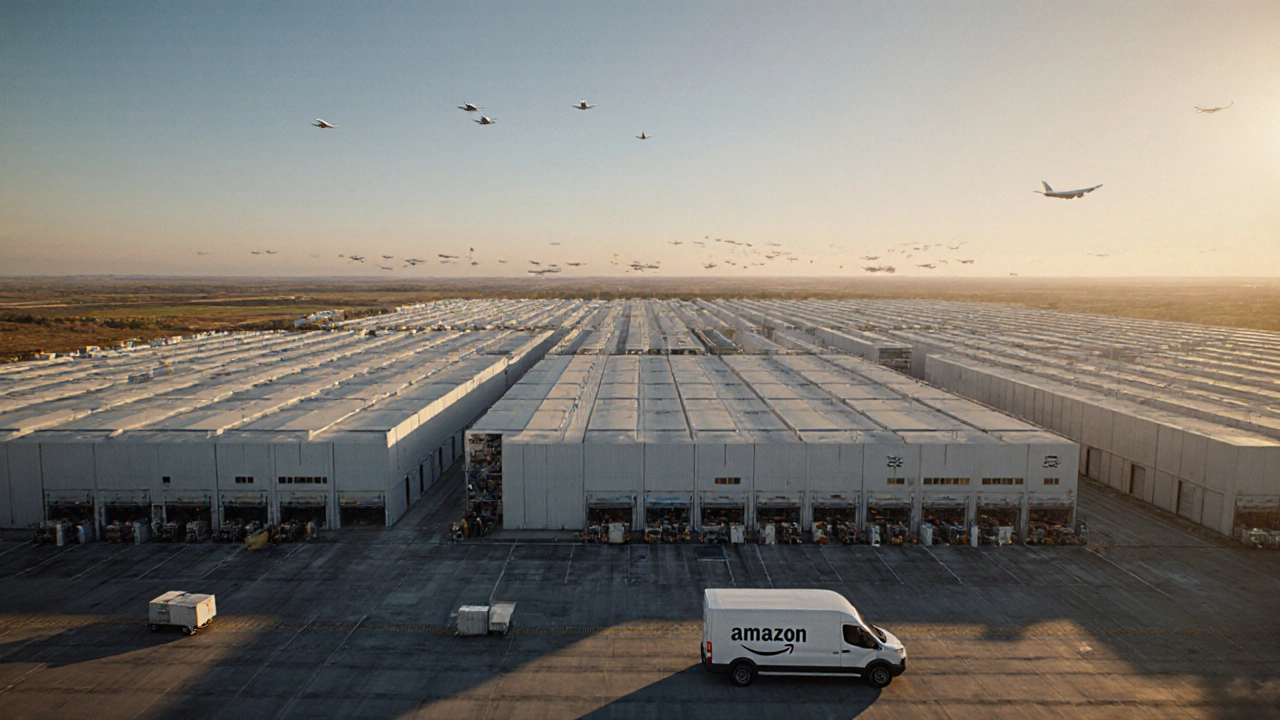Most Popular E‑commerce Company in 2025 - Who Leads the Market?

E-commerce Market Leader Calculator
The article shows how Amazon leads by revenue, Alibaba by GMV in Asia, and Walmart by US market presence. Adjust the weights below to see which company leads based on your priorities.
Adjust Your Priority Metrics
Assign weights to each metric to see which e-commerce company would be the market leader based on your criteria
Your Custom Leader
Based on your metric weights, we calculated the top e-commerce company for your criteria.
Adjust your metrics and click 'Calculate Market Leader' to see your results.
Quick Takeaways
- Amazon remains the clear market leader in 2025, topping revenue, active users and fulfillment network size.
- Alibaba holds the strongest position in Asia, especially in China’s domestic market.
- Walmart’s online push places it as the top U.S. retailer outside Amazon.
- Shopify powers millions of independent stores, ranking high in growth rate and merchant count.
- Cross‑border sales and fast‑delivery logistics are the key differentiators among the top players.
What Makes a Company “Popular”?
Popularity in e‑commerce isn’t just about brand name recognition. Analysts typically measure three core signals:
- Gross Merchandise Volume (GMV) - the total value of goods sold on the platform.
- Active Customer Base - monthly unique shoppers who make at least one purchase.
- Logistics Footprint - the size and speed of the fulfillment network that fuels fast delivery.
When you line up the major players against these metrics, a single name dominates the chart.
Amazon: The Undisputed Leader
When you think about the Amazon the world’s largest online retailer, you instantly picture a sprawling network of fulfillment centers, two‑day shipping, and a marketplace that hosts millions of third‑party sellers. In 2024 Amazon generated US$591 billion in worldwide e‑commerce revenue, a 9 % jump from the previous year. Its Prime membership program now boasts over 230 million subscribers, each expecting sub‑24‑hour delivery on millions of items.
Key factors that keep Amazon on top:
- More than 1.8 million square feet of fulfillment space across 175 locations.
- AI‑driven inventory forecasting that reduces stock‑outs by 23 %.
- Extensive cross‑border logistics - shipments to over 200 countries in the last 12 months.
- Marketplace model that lets small sellers reach a global audience without building their own logistics.
Alibaba Group: The Asian Powerhouse
Alibaba dominates the Chinese market with platforms like Taobao, Tmall and AliExpress. In 2024 its e‑commerce GMV hit CNY 9.1 trillion (≈ US$1.3 trillion), outpacing Amazon’s GMV in Asia alone. While Alibaba’s Western consumer sales are modest, its logistics arm - Cainiao - handles more than 10 million parcels daily, ensuring same‑day delivery in China’s top tier cities.
Alibaba’s strengths lie in:
- Deep integration of payment (Alipay) and cloud services (Alibaba Cloud) into the shopping experience.
- Rural e‑commerce initiatives that bring online sales to over 200 million new customers each year.
- Live‑stream shopping, which contributed US$100 billion in sales during 2024.

Walmart: The U.S. Retail Giant’s Digital Leap
Walmart’s online sales crossed US$79 billion in 2024, making it the second‑largest e‑commerce retailer in the United States after Amazon. The company leverages its 10,500 brick‑and‑mortar stores as micro‑fulfillment hubs, shrinking last‑mile delivery times to under 48 hours in most markets.
What sets Walmart apart:
- Buy‑Online‑Pick‑Up‑In‑Store (BOPIS) processed 70 million orders in 2024.
- Partnerships with third‑party logistics providers (e.g., DHL, FedEx) to expand same‑day delivery in metro areas.
- Strategic acquisitions of e‑commerce platforms like Flipkart (India) and Jet.com (U.S.) that broaden its global footprint.
Shopify: The Platform Powering Independent Sellers
Shopify doesn’t sell products itself; instead, it powers over 2 million merchants worldwide. In 2024 its Gross Merchandise Volume reached US$155 billion, and the platform’s revenue grew 14 % year‑over‑year.
Key reasons Shopify ranks high in popularity:
- Ease of store setup - a non‑technical founder can launch a store in under 30 minutes.
- Robust app ecosystem that adds everything from AI‑driven product recommendations to multi‑carrier shipping calculators.
- Shopify Fulfillment Network (SFN) now operates 30 warehouses across North America and Europe, offering 2‑day delivery for millions of merchants.
eBay and Other Notable Players
eBay still commands a sizeable consumer base, especially for used and collectible items. Its 2024 GMV topped US$36 billion, placing it behind the top four but ahead of most niche platforms.
Other regional leaders include JD.com (China), Mercado Libre (Latin America), and Rakuten (Japan). Each brings unique strengths - JD.com’s drone delivery trials, Mercado Libre’s integrated fintech services, and Rakuten’s loyalty ecosystem.
Comparison Table: Traffic, Revenue & Logistics
| Company | 2024 Revenue (USD) | GMV (USD) | Active Users (Millions) | Fulfillment Centers |
|---|---|---|---|---|
| Amazon | 591 B | 730 B | 310 | 175 |
| Alibaba | 108 B | 1,300 B | 750 | 180 (Cainiao network) |
| Walmart | 79 B | 215 B | 150 | 150 (store‑based hubs) |
| Shopify | 5.5 B | 155 B | 2,200 (merchant count) | 30 (SFN) |
| eBay | 10.4 B | 36 B | 132 | 12 (partner warehouses) |

Why Logistics Matter for Popularity
Fast, reliable delivery is the hidden engine behind every top‑ranked e‑commerce brand. Amazon’s investment in robotics, Alibaba’s Cainiao smart‑routing system, and Walmart’s use of its physical stores as mini‑fulfillment hubs all shrink delivery windows to a day or less. When shoppers know they’ll get their order tomorrow, they’re more likely to return - a direct boost to the active‑user metric.
Even platform‑only players like Shopify are racing to improve logistics. The Shopify Fulfillment Network promises 2‑day delivery for merchants without requiring them to build their own warehouses. As a result, independent stores can compete on speed with the giants.
Future Trends Shaping the Next Leader
While Amazon holds the crown today, several trends could reshape the hierarchy by 2027:
- AI‑driven personalization - Companies that can predict what a shopper wants before they search will capture higher conversion rates.
- Green logistics - Carbon‑neutral delivery options are becoming a purchasing factor, especially in Europe and North America.
- Embedded commerce - Social platforms (e.g., TikTok Shop) are turning content into instant checkout, blurring the line between discovery and purchase.
- Regional market consolidation - In markets like India and Southeast Asia, local giants such as Flipkart and Lazada may combine forces to challenge the global players.
Keep an eye on how these forces influence GMV, user growth, and logistics spend - the metrics that decide who’s truly the most popular.
How to Leverage This Knowledge for Your Business
If you run an online store or are planning to launch one, here’s a quick checklist based on what the market leaders do best:
- Invest in fast shipping: Partner with carriers that offer same‑day or next‑day options in your core markets.
- Use a marketplace model: Even if you sell your own brand, opening up third‑party listings can instantly grow traffic.
- Integrate AI tools for inventory forecasting and personalized product suggestions.
- Consider a fulfillment partner like Shopify Fulfillment Network or a 3PL that can scale with you.
- Measure the three popularity signals (GMV, active users, logistics footprint) each quarter to know where you stand.
Frequently Asked Questions
Which e‑commerce company has the highest revenue in 2024?
Amazon leads with US$591 billion in e‑commerce revenue, followed by Alibaba at US$108 billion.
How does Amazon achieve such fast delivery?
A massive network of fulfillment centers, AI‑driven inventory placement, and its own logistics arm (Amazon Logistics) enable sub‑24‑hour delivery for Prime members in many regions.
Is Shopify considered an e‑commerce company?
Shopify is a platform that powers e‑commerce stores. While it doesn’t sell products directly, its merchant base and GMV make it a key player in the market.
What is the role of logistics in e‑commerce popularity?
Fast, reliable logistics directly influence repeat purchase rates. Companies with larger, more efficient fulfillment networks tend to have higher active‑user counts and GMV.
Will any company overtake Amazon soon?
It’s possible, but a challenger would need to match Amazon’s scale in revenue, global logistics, and Prime‑like loyalty programs. Emerging trends like AI personalization and green delivery may narrow the gap.